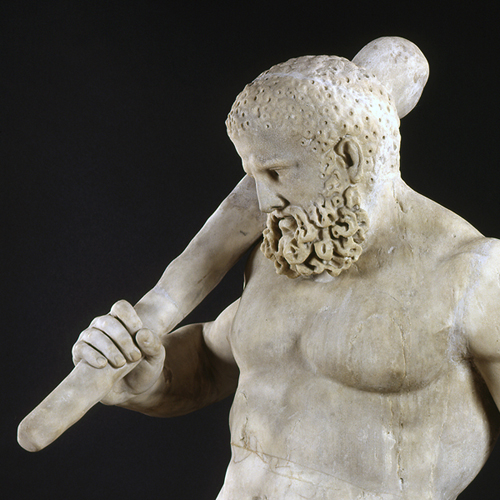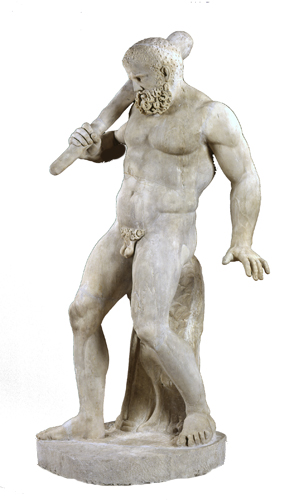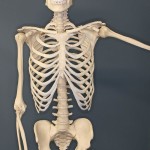
Herakles
Roman, after a Hellenistic original, 2nd Century
(marble)
North Carolina Museum of Art, Raleigh
Let’s go back in time to the ancient world and meet a hero who had superhuman strength.
Here we have a hero from ancient Greek and Roman mythology. What do you first notice about him? He isn’t wearing any clothes! He is nude. Are you strong? Are you athletic? Isn’t it easier for others to see your muscles when you’re wearing athletic clothing or short sleeves? For ancient people who made sculpture like this, the body was seen as possessing great strength and beauty. They liked to represent the human body in their art. Look closely. Did the artist show a man of great strength? How so? Look at the muscles on his arms and chest. What if I were to tell you “a strong mind and a strong body” was an ancient Greek motto? Would that help you to better understand this work of art? In ancient Greece, clever speaking and knowledge were seen as important for success—but so was personal physique. To prepare for athletic contests and to prepare for battle, men would visit gymnasiums and exercise and wrestle. Is this similar to our own time and place? Do men and women of today visit gyms and exercise to build up their muscles and get in shape? They do.
 What do muscles do exactly? They cause motion. Contraction of the skeletal muscles, for example, causes the body to move. What is the human skeleton? It is a system of the body. It is like a scaffold that anchors the muscles and protects and supports the organs, such as the brain, lungs and heart. The human skeleton consists of both fused and individual bones. What are the functions of bones? Bones support, protect and produce locomotion. What about joints? Joints are where two or more bones make contact. What do joints do? They allow movement similar to the movement of mechanical devices. What types of joints are there in the human body? There are hinge joints, ball and socket joints, and gliding joints.
What do muscles do exactly? They cause motion. Contraction of the skeletal muscles, for example, causes the body to move. What is the human skeleton? It is a system of the body. It is like a scaffold that anchors the muscles and protects and supports the organs, such as the brain, lungs and heart. The human skeleton consists of both fused and individual bones. What are the functions of bones? Bones support, protect and produce locomotion. What about joints? Joints are where two or more bones make contact. What do joints do? They allow movement similar to the movement of mechanical devices. What types of joints are there in the human body? There are hinge joints, ball and socket joints, and gliding joints.
Look closely at this figure. Does he appear to be in motion? Yes, it appears that at this very moment he has stopped in his tracks to either take a closer look at something or recoil from something he has just done. How has the artist shown this? The figure’s torso is compact, his right leg is advanced, and his left arm is low and off to the side. He appears to be trying to steady himself. Who is he? Do you know? He is one of the heroes in the myths told by the ancient Greeks and Romans. What are myths? Myths are stories that try to explain how the world and humankind came to be. This figure is Herakles. Who was Herakles? In ancient Greek mythology, Herakles was a figure of great strength, courage and cleverness. He was the son of the king of the gods, Zeus, and a mortal mother named Alcmene. Zeus’ wife, the goddess Hera, was jealous of Alcmene. She hated Herakles with a passion. When Herakles was only eight months old, Hera sent two giant serpents down to earth to kill him. But Herakles was strong. He grabbed a serpent in each hand and strangled them both. He was soon found by his nurse playing with them as if they were mere toys. This would be the first of many monsters Herakles would vanquish by his own hands.
Just because Herakles was a hero, however, doesn’t mean he didn’t do bad things. As a young man Herakles is driven mad by the goddess Hera and ends up killing his own children. As punishment for his crime, Herakles has to undergo twelve superhuman labors instructed to him by his archenemy, Eurystheus. In his first labor Herakles has to figure out a way to kill the monstrous Nemean lion, whose golden fur is invulnerable to all weapons. After he kills the lion, he must return with its pelt (skin). In one version of the tale, Herakles blocks up one opening of the cave where the lion is hiding and enters by the other. He then fights the lion with his club. When the lion shows signs of weakening, Herakles drops his club and suffocates the lion to death. He then tries to skin the lion’s pelt with a knife but is unable to do so. The goddess Athena whispers to Herakles to use the lion’s own claws, since its claws are sharper than mortal swords. Herakles does as he is told. He uses the lion’s claws and quickly skins its pelt! Do you see any clues here that illustrate the details of this story? Look carefully. What is Herakles holding in his right hand? He is holding the club he uses to fight the lion. Can you tell what is at his feet? A lion’s pelt is draped over a tree trunk. The club and lion’s pelt are clues that tell you the figure is the hero Herakles.

Depiction of Atlas holding up the heavens, by unknown artist, second half of 16th century
Often myths are stories that try to explain the forces of nature. For example, ancient people wondered why the sky did not fall to earth. Today we know the earth’s atmosphere is a layer of gasses that is held in place by the earth’s gravity. We also know the earth and other planets in our solar system are kept in orbit around the sun by the sun’s gravity. The ancient Greeks could only guess why the sky did not fall to earth. Perhaps in part to explain why, they made up a myth about a giant named Atlas who had to stand at the edge of the earth and hold up the heavens for all eternity.
In one of his labors Herakles tricks the giant Atlas. How so? Herakles has to fetch several golden apples from Hera’s garden. Since Atlas knows exactly where the tree is that bares the golden fruit, Herakles asks Atlas for his help. Herakles first slays the dragon that guards the apples, and then Atlas goes to fetch the golden fruit. While Atlas is gone, Herakles holds up the heavens for him. Soon Atlas returns with the apples, but instead of taking the heavens back onto his shoulders, he tries to trick Herakles into carrying the sky forever by offering to deliver the apples himself. Since anyone who holds up the sky must carry it until someone else takes it away from them, Herakles uses his wits to trick Atlas instead. He convinces Atlas into taking the heavens back onto his shoulders for a moment while he rearranges his cloak. Thinking he will hold up the heavens only for a brief moment, Atlas sets the apples down and takes the heavens back onto his shoulders. But it is a trick! Herakles quickly snatches the golden apples and runs off, leaving Atlas with no choice but to hold up the sky!
§
Would you like to see Herakles in person? All you have to do is visit the North Carolina Museum of Art in Raleigh, North Carolina. Herakles is in the Classical Court at the museum. Or perhaps you would like a tour. Tours of the collection are given daily, except for Monday when the museum is closed to the public. If you prefer, you can contact the museum ahead of time and arrange for you and your friends to have a private tour. I’m sure a docent at the museum would be happy to show you and your friends Herakles and many other works of art. Whether you visit the museum on your own or have a tour with a docent, it will be well worth your time!
